This is the promised follow-up to the previous two posts (the one about my summer road trip through England and the other about yet more DT in London). So now to the Channel Islands, where I travelled to after London, first by train to Poole and then by ferry from there to Guernsey.
The ‘Channel Islands’ is a cover term for an archipelago of islands located in the English Channel (hence the designation) but geographically much closer to Normandy in France (to which they once belonged) than to Great Britain. The islands are British ‘Crown Dependencies’ and as such (like the Isle of Man or ‘Overseas Territories’ like the Falklands) they are not part of the UK, though still considered British … and the British monarch is nominally the head of state. The only aspect London remains in charge of is defence. Yet the islands are self-governed. They even issue their own banknotes, though that is tied to the British Pound Sterling, which is also legal tender on the islands (though Channel Island banknotes may not be accepted in the UK).
The Channel Islands actually fall into two entities called ‘Bailiwicks’ (with a ‘bailiff’ as governor), one for Jersey, the largest and most southerly of the group, and the Bailiwick of Guernsey, which comprises not only the island of that name (the second largest, located in the middle of the archipelago) but also its two much smaller neighbours Sark and Herm as well as the northernmost of the group, Alderney. The two governments are nominally independent of each other, although in practice there is co-operation, and a few institutions are not doubly represented (e.g. the stock exchange). Most of the inhabitants speak English, although there are also a small number of speakers of previously more common, Norman-derived languages closer to French. The French legacy, however, is still very visible in many a place name on the islands.
But so much for a brief overview so all readers know where and what the Channel Islands are. What about dark tourism (DT), then? Well, the Channel Islands, at least the three largest ones, are significant DT destinations primarily for the fact that during WWII the archipelago was occupied by Nazi Germany! They were in fact the only parts of British soil that the Nazis managed to invade. Some of the population were evacuated before the arrival of the Germans, especially most children and men of military age who joined the British/Allied forces in Great Britain. Of those islanders who remained, a couple of thousand were then deported by the Nazis to civilian camps in Germany and France. For those people who remained on the islands, five long years of hardship ensued, especially after D-Day when the islands were cut off from supplies from the mainland and hunger became prevalent, both for the occupied and eventually the occupiers too.
For the Germans stationed on the Channel Islands, it was up to that point a comparatively easy posting, away from the battles in mainland Europe. Also the regime exercised by the occupiers was somewhat less harsh and brutal than in other regions/countries under Nazi rule. There was relatively little resistance and even a certain degree of fraternization and collaboration – which these days is not a popular topic to broach on the islands. Similarly, the fact that the islands’ small Jewish community suffered the worst fate and mostly ended up being deported and killed in the Holocaust (especially at Auschwitz).
Affected most by the occupation was Alderney, where almost the entire population was evacuated or deported. The Nazis then embarked on a massive programme of fortification, under the aegis of the infamous Organisation Todt (OT). Lots of bunkers and gun emplacements were built – all through the use of slave labourers, many of whom were transported here from Nazi-occupied territories and, like elsewhere, were housed in concentration camps. Alderney had four such camps (called Sylt, Borkum, Norderney and Helgoland, after German North Sea islands) – usually these are regarded as the only German concentration camps on British soil, although there would have been labour camps on Guernsey (and Jersey) as well.
My plan after arriving in Guernsey was to get the passenger ferry to Alderney the next day and stay overnight there. I had already booked a hire car for extensive DT explorations on the island. However, it never came to that: owing to high winds and consequently rough seas the ferry was cancelled. So my plan of visiting and documenting well over a dozen Alderney DT sites fell through entirely. I’ll have to make another attempt some other time.
This meant I had more time on Guernsey, which thus was my main area for exploration. My wife and I based ourselves in the island’s capital of St Peter Port, and initially set about exploring on foot. In the centre of the town’s waterfront a prominent monument marks the Liberation of the island on 9 May 1945. Here’s a photo of the structure, which incorporates a Churchill quote:
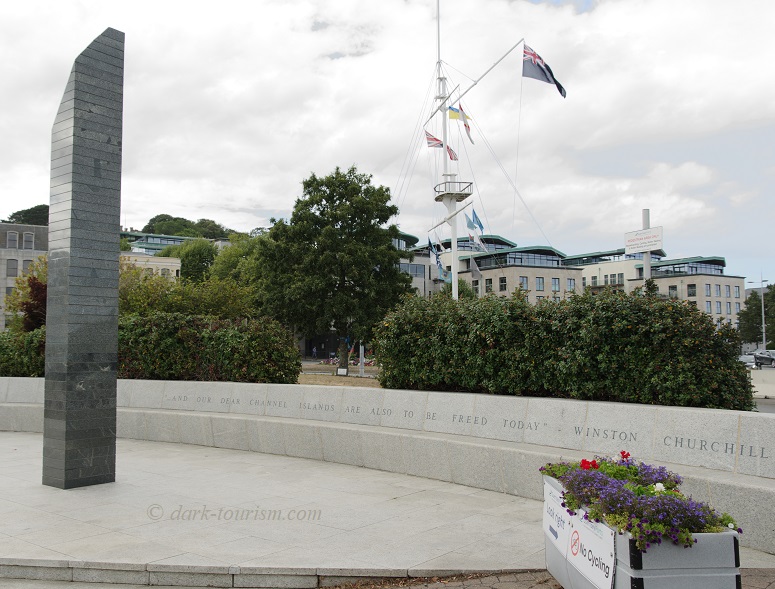
As this year marked the 80th anniversary of the liberation, there were also lots of references to this to be seen, posters, wall murals and there is even a “Liberation Trail”.
Also to be found by the harbour front were several memorial plaques, e.g. for those killed in the initial bombing of the town by the German Luftwaffe in 1940, another is dedicated to those islanders deported from Guernsey, yet others to the slave labourers and to Guernsey’s Jewish victims. There’s even a plaque dedicated to the 14 people from Guernsey who perished in the sinking of the Titanic!
But the first proper full-scale dark-tourism attraction we visited was the La Valette Underground Military Museum on the southern edge of town:
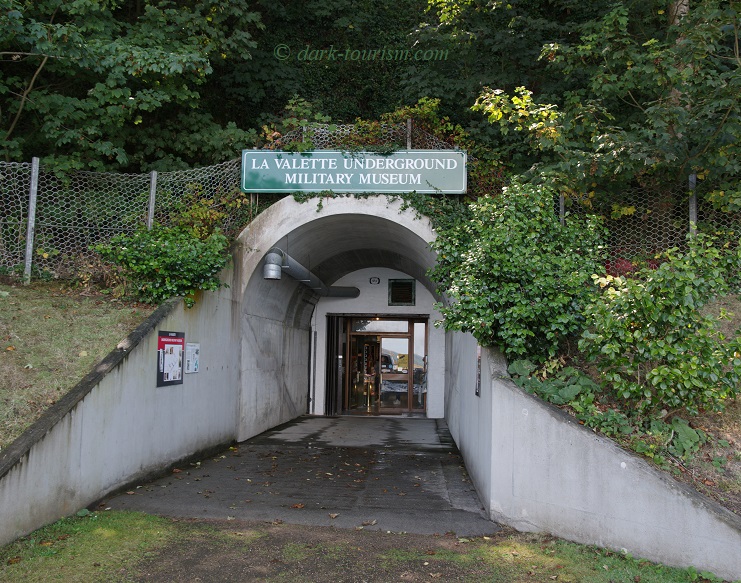
This is located in tunnels dug by the Nazis (well, their slave workers), as was the case in several places across the islands (see below for two more examples). Inside these tunnels is now a vast collection of exhibits, some large (like whole vehicles) many small, such as documents and posters from the time of the occupation, countless guns, helmets, uniforms, medals, communications gear and whatnot, so mostly militaria, including plenty of swastikas on display, on medals, flags, papers. Here’s a view of the main tunnel:
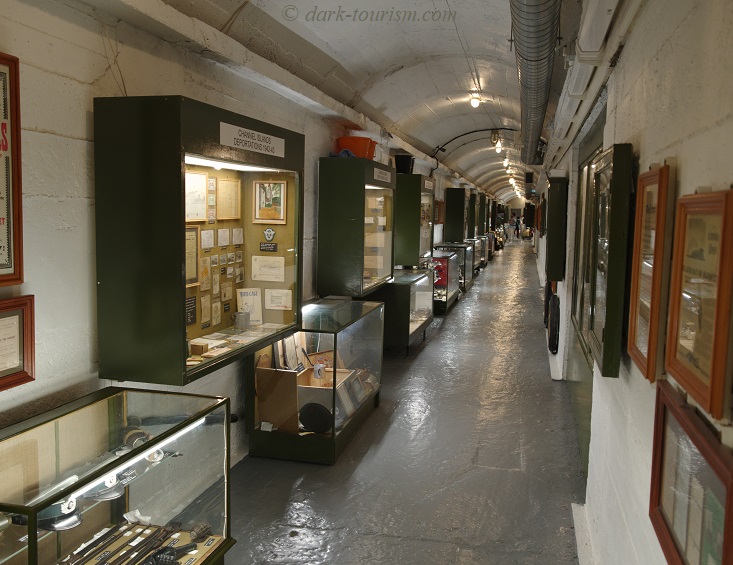
Branching off the main tunnel are several shorter ones, one of which leads to the main entrance pictured above. At one end of the main tunnel an unfinished tunnel branches off, which serves as an illustration of the hard labour conditions involved in the construction of these sites:
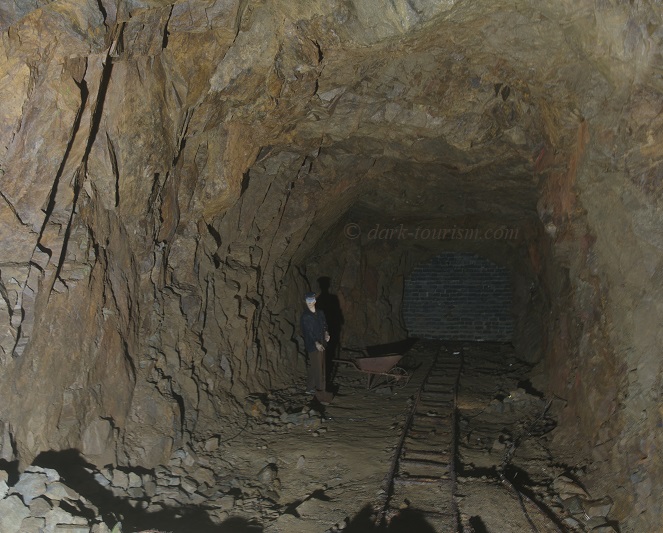
This is just a little taster – in the full-length new chapter to be written for my main website I will be able to go into much more detail. The same applies for the rest of this post – it’s just an overview and photo essay.
The next day we visited the other main occupation-era-related site within St Peter Port, namely the bunker for the former German Navy Signals HQ:
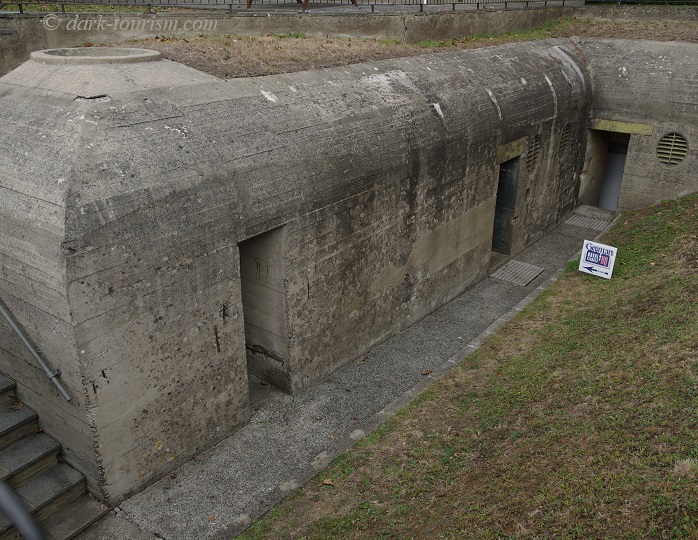
The inside has been “lovingly” restored to look much like it did back when it was in use, complete with lots of communications equipment “manned” by dummy soldiers in German Navy uniforms:
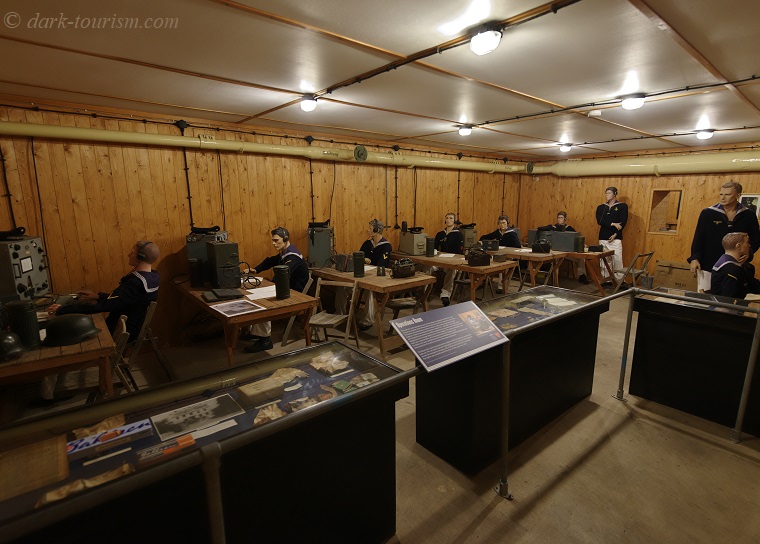
For the rest of my explorations of Guernsey I was greatly aided by a fellow dark tourist and long-time follower of my main website and this Blog. For many, many years he had been a resident in Guernsey (though he now lives in France) and knows all its dark sites in and out. He had borrowed a car to drive us around, so we could reach sites that would otherwise not have been so easy to get to, and generally acted as a guide, providing many eye-opening local insights. (Thanks again, Simon!)
The first place we visited was the secluded Fort George military cemetery:
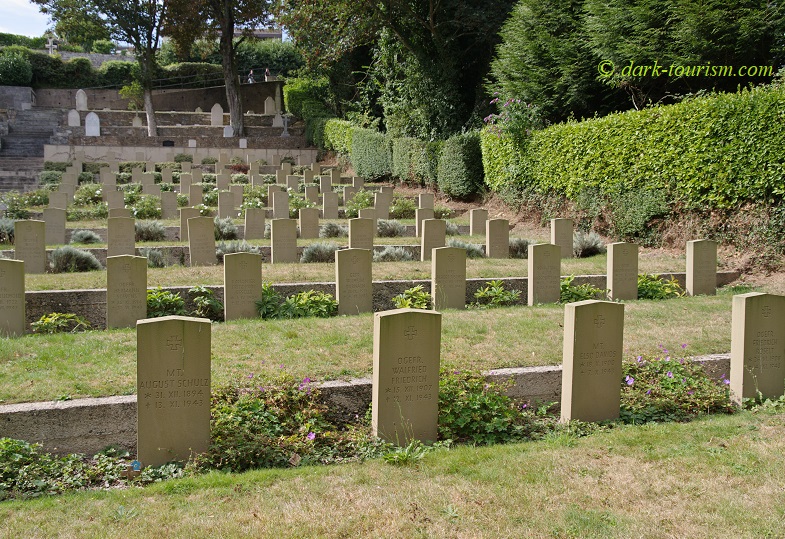
The German military graves here are not for soldiers who died in battle (there weren’t any battles on the Channel Islands), but for those who must have died in e.g. accidents, or from natural causes. It’s not really legible in this small photo, but the second row of headstones in this frame includes one with a remarkable, very unusual name on it: Alois Hassdenteufel. Translated literally that surname means “hate the devil” in English!
We then drove to the west coast to see some of the larger concrete fortifications constructed during the German occupation. That included this former observation tower:
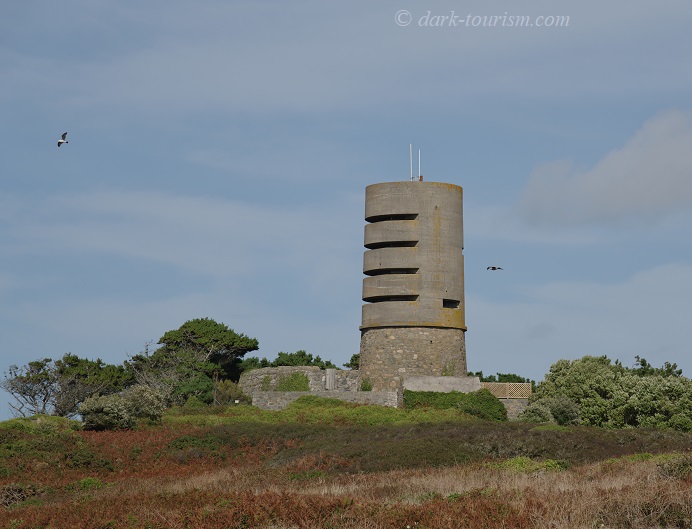
There are many such structures across the main Channel Islands. A couple are occasionally made accessible to visitors – but not this one, as I was informed, because it’s now private property. I wonder how the owners use the interior these days.
Freely accessible, in contrast, was the Battery Dollmann at Pleinmont, complete with one restored 22cm coastal gun with reapplied camouflage painting:
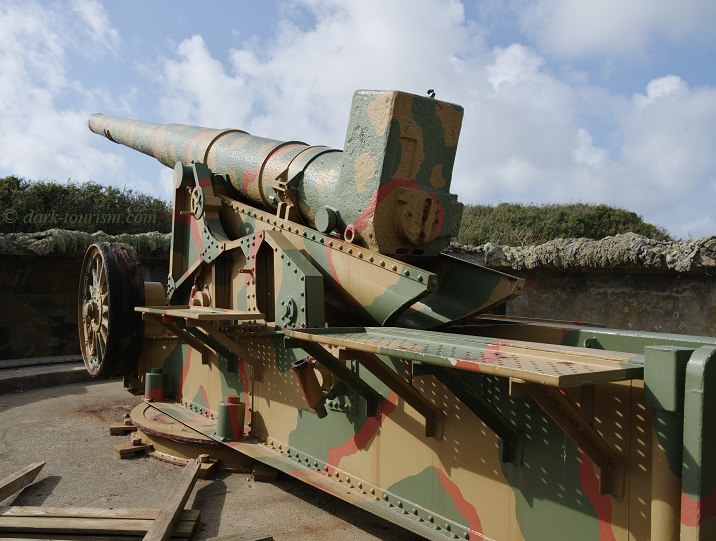
Not far from there you can see what must be the most iconic of all the WWII structures on Guernsey, the MP 4 observation tower/bunker. MP stands for “Marine Peilstände” (‘Navy range-finding stations’) and it was the fourth of five built on the island (out of a planned eight). They supported coastal gun batteries in finding their targets. This one, also referenced as “L’Angle”, you find pictured in many books, brochures, charts and whatnot on Guernsey – and the photo of it below was hence also chosen as the featured one at the top of this post:
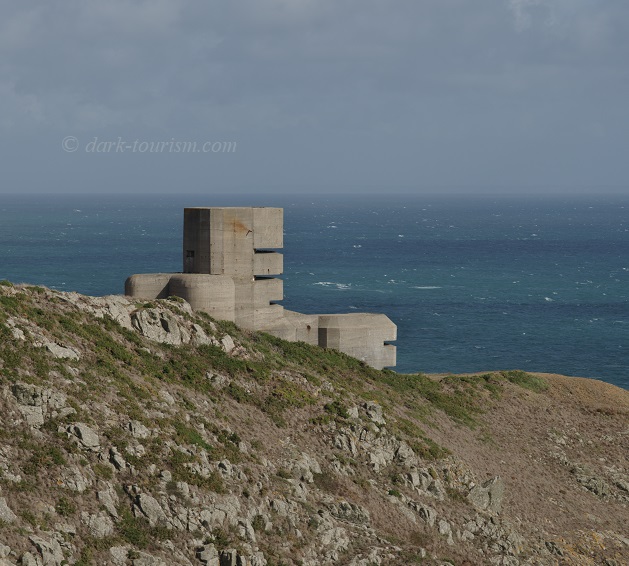
Further north stands another observation tower, numbered MP 3, the interior of which is sometimes accessible and there’s lots of original and restored equipment to be seen there. But opening times are so restricted that they didn’t tally with my time on Guernsey.
The next day our first major port of call was the Guernsey Occupation Museum, run by an ancient guy allegedly old enough to have lived during the occupation. The collection of items from that time on display inside is vast.
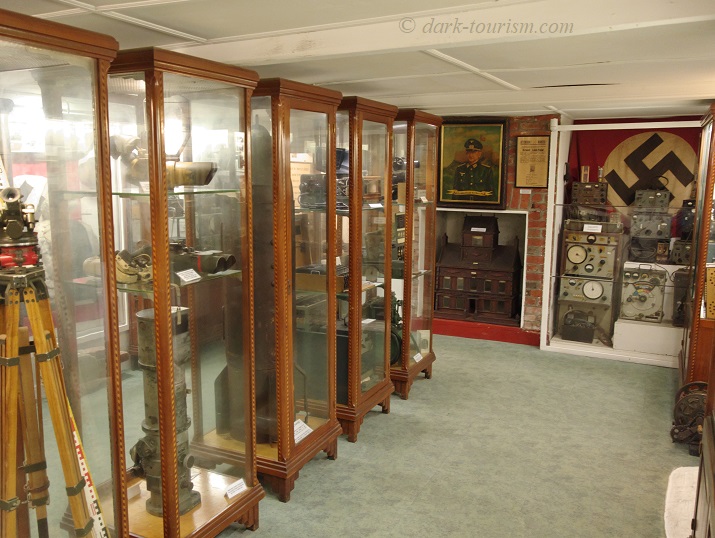
Again, militaria dominate what’s on display, from small items like documents, grenades, gas masks, communications gear, rangefinders, etc., to large ones like flak batteries and even a full-size coastal gun. There’s also an “Occupation Street”, a life-size reconstruction of a street in a Guernsey town, including an original fire engine, plus several tractors and horse-drawn carriages.
From a dark perspective, the most significant sections have to be those about the camps in Germany for deported islanders, the imprisonment of people on the island itself and the forced labourers and their concentration camps on Alderney. Amongst the exhibits is this original striped clothing worn by an inmate from Camp Sylt:
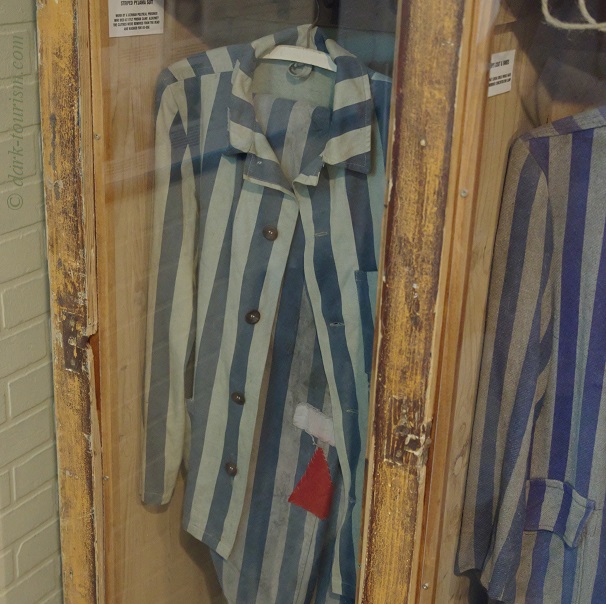
Also not swept under the rug here is the fate of the Jews of the Channel islands. Items on display include the inevitable yellow Jewish star, while a shower head marked “similar to shower heads at Auschwitz-Birkenau” is perhaps a bit much … (and may be born out of, or at least reinforce the erroneous conception that in the gas chambers of Auschwitz the gas was piped in through fake shower heads).
The next dark highlight (if that’s not a contradiction in terms) was the German Underground Hospital in a somewhat hidden inland location:
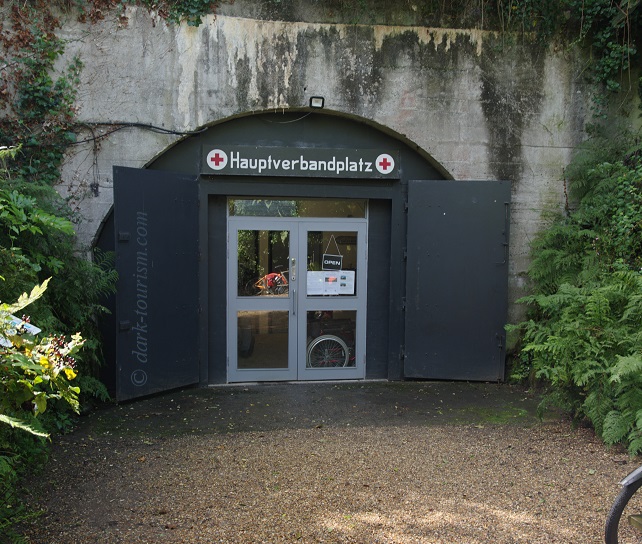
The word above the entrance you can see in this photo translates literally as ‘main bandaging place’. Inside most of the tunnel system is just bare, damp and only gloomily lit:
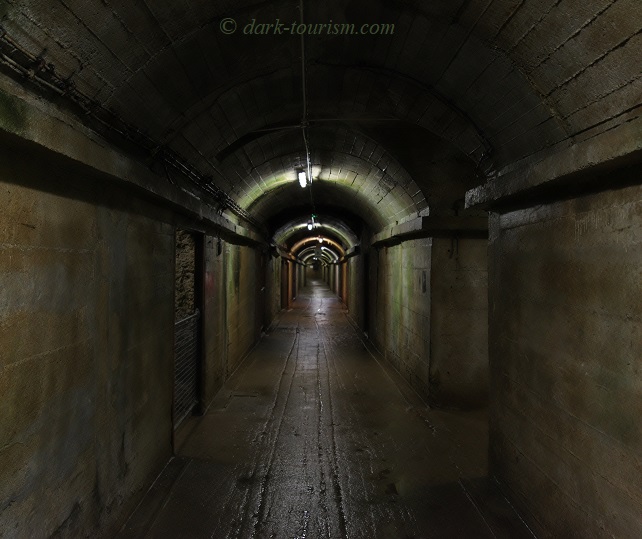
Only at certain points are there a few exhibits, such as a couple of vehicles as well as tunnelling equipment. In one side tunnel is an exhibition called “On British Soil” which is about the occupation, the resistance, the slave labourers and there’s also a section about Guernsey’s Jewish victims. Another side tunnel features a very rough reconstruction of a hospital ward:
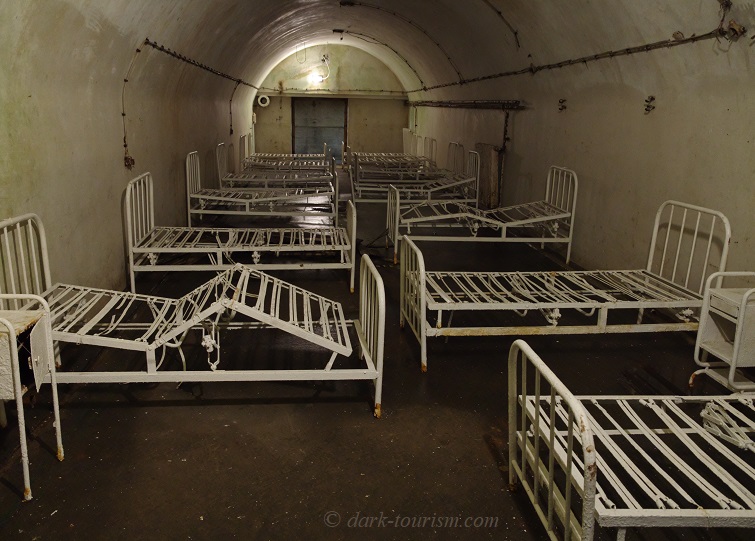
Although the site is only commodified to a minimal degree, and despite the damp, grime and gloom, I must say I quite liked this place precisely for it being so raw! It could deserve a photo essay of its own. But for this overview post’s sake, let’s move on.
The last major point to be visited was one we had briefly already passed the day before, but this afternoon one of the bunkers was open. It’s part of the Fort Hommet complex of bunkers and is a finely restored gun casemate:
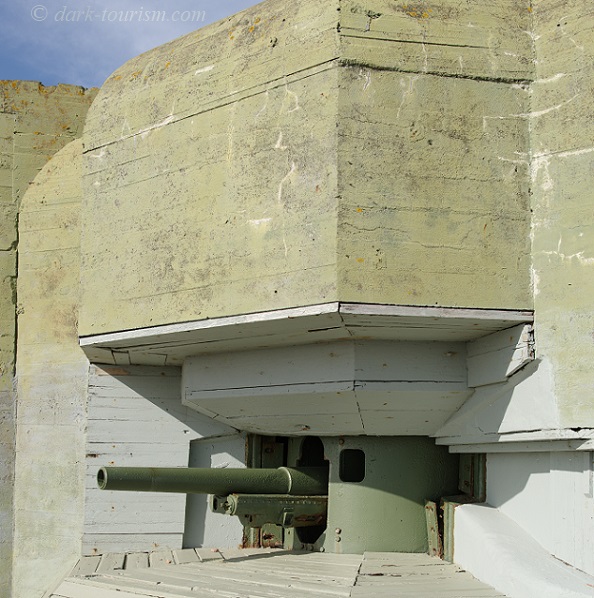
The place is run by the Guernsey Occupation Museum see above), and the similarity in style was palpable. The main part is the “other” side of that gun seen in the photo above. Here’s what it looks like from the inside:
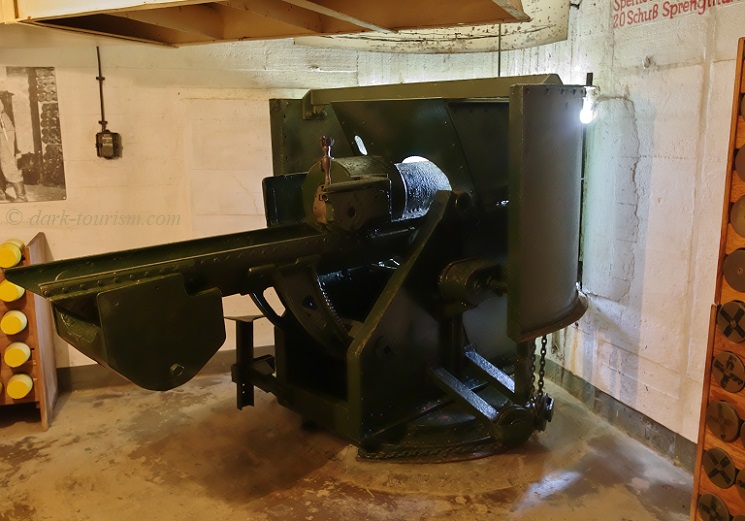
The rest of the interior features reconstructed ammunition stores, ventilation systems, some small guns and display cabinets with yet more smaller-scale militaria. One room consists of a life-size reconstruction of the living quarters at this site, complete with two dummy German Nazis having a jolly time off duty:
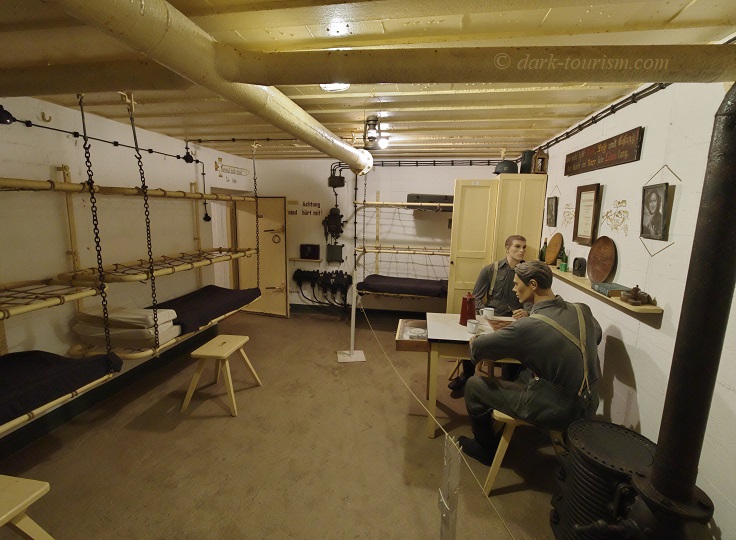
That was the final point on our DT tour of Guernsey. So we were dropped off at our hotel, had a thank-you drink with our guide for the past two days, and then that should have been it for Guernsey.
But during the day we had received a notification that our ferry onwards to Jersey the next day was also cancelled, and we had to rebook for a crossing the day after. So that meant we had yet another extra night and a full day in St Peter Port before we could travel on. We made it a largely non-DT day, just leisurely exploring the pleasant town and indulged in some retail therapy as well as nice food and drink.
The plan had been to get an afternoon ferry so that we would have a whole day for exploring Jersey with the hire car that I had booked. Now we had to get a morning ferry the following day so we notified our accommodation and the car hire company that we would be late, but hopefully get there eventually.
After disembarking at Jersey’s ferry terminal and making our way to check into our accommodation (a self-catering apartment that we knew we’d now use much less than was intended), we just dropped off our luggage and raced to the bus station to catch a bus to the airport, from where the hire car was booked. The car pick-up was thankfully very easy, and so, with just one afternoon at our disposal, we set about ticking off as much of my original itinerary for Jersey as was possible in the shorter time we had.
The first site we drove to is the most significant and by far the most visited WWII-related attraction in the whole of the Channel Islands, the so-called Jersey War Tunnels:
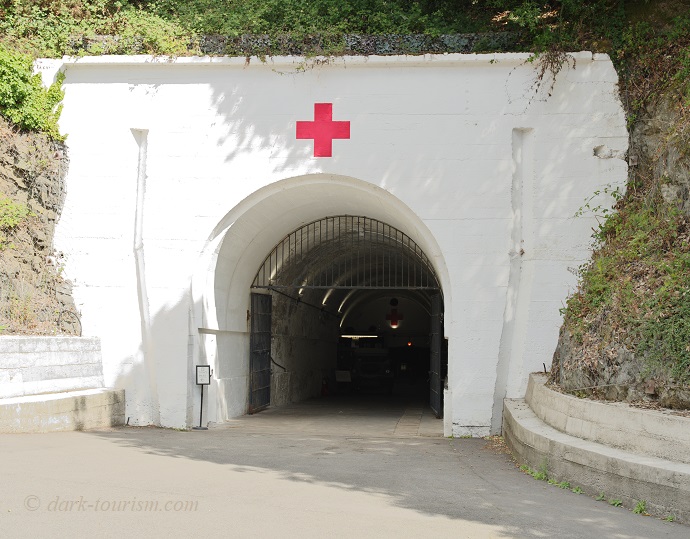
Similarly to the equivalent on Guernsey (see above), this complex was initially intended as an air-raid shelter and barracks for soldiers, and of course it was built, as usual, by forced labour from the OT. But from late 1943 the tunnel complex was converted into a hospital. Apparently wounded German casualties from D-Day and the Battle of Normandy were shipped here for treatment in 1944.
After the war the complex first fell into disuse, but was soon opened to the public and gradually became a visitor attraction. Over the past two decades or so substantial commodification and restoration efforts have been undertaken, and today the museum inside the tunnels can be regarded as the most “state of the art” in the Channel Islands. It’s a far cry from the jumble-room-like character of some of the war-related museums I had seen on Guernsey. However, and it’s a big BUT, the commodification is frequently quite over-the-top and the animated dummies and light-and-sound-show elements make the place feel rather unauthentic and overdramatized (or, as my Guernsey friend said: inside there it’s all a Disney show). Here’s a mild example:
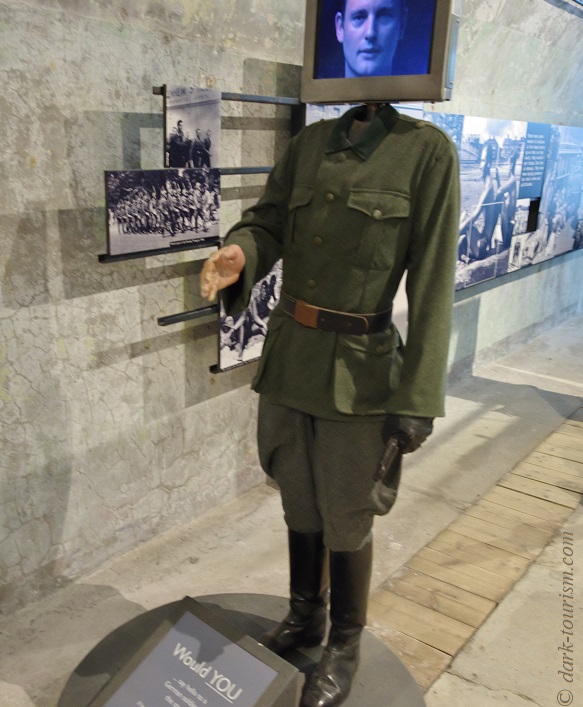
In one room there were installations involving Nazi German dummy soldiers in uniform featuring instead of a head little screens with a face on it. They had different postures and at this one visitors were quizzed whether, had they lived during the German occupation, they would have shaken a German soldier’s hand in the street (others asked whether one would have invited a German into their house or have done their laundry or such things). I found it a bit forced and overly “interactive”, as it were …
The best bits, in my view, were the really quite lifelike reconstructions of living quarters, a nurses’ station and in particular this hospital operating theatre:
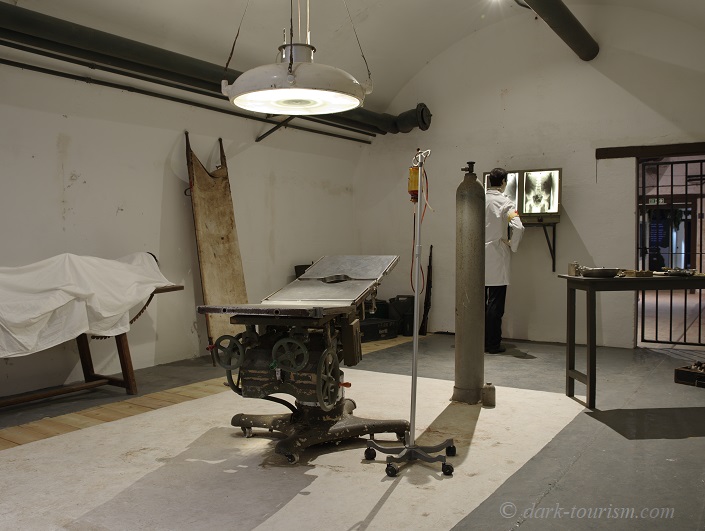
After having spent quite a bit of time in the Jersey War Tunnels we moved on to the Channel Islands Military Museum in L’Etacq on the western coast of Jersey, which was fortified with a series of bunkers, gun emplacements and a long concrete wall parallel to the beach. The museum is housed in one of those bunkers and features an old tank turret on top and flies a Union Jack (as opposed to Jersey’s flag!):
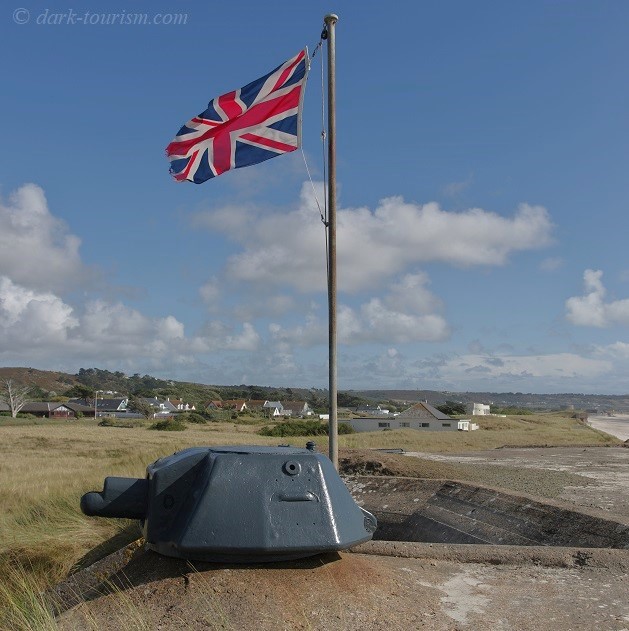
Inside, the museum features the most jumble-room-like collection of militaria I have seen in the Channel Islands. They even trade in militaria: in the museum shop you can buy all manner of more or less rare wartime relics, and some of the clientele I witnessed here were positively enthusiastic about that. Those who get a thrill out of seeing original artefacts from WWII and Nazi memorabilia will love this museum too. I must say, though, that I was less enamoured with it. I found it too crammed full and having seen several other museums with such a focus on militaria I was reaching saturation point. That said, though, there were some remarkable exhibits, and for me those were rather the not-so-military smaller items, such as a collection of Nazi-symbol-bearing crockery or a photo of a Nazi-uniformed man with a Jersey cow that came with the sarcastic caption “A German officer interrogating one of the locals”. Similarly it’s more the little things in this next photo too: look past the life-size Flak installation and spot the circular painting of a stag on the wall – classic German kitsch!
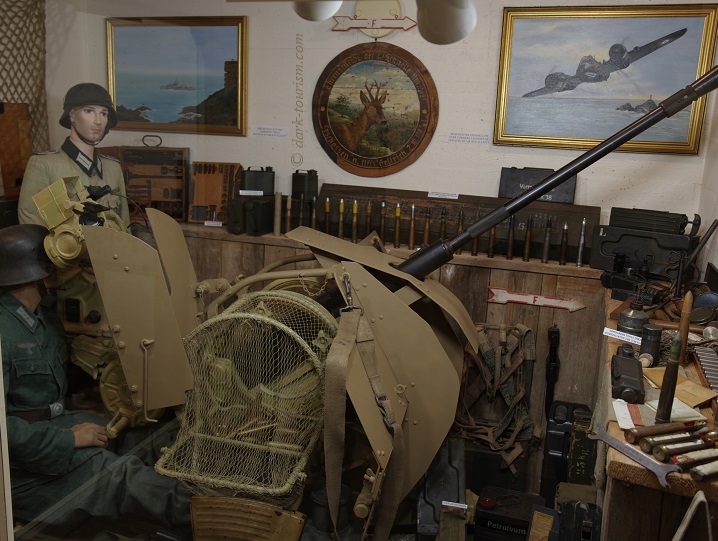
Amongst the heaps of relics and equipment was also an original Enigma machine, as seen in the next photo – note also the copy of a “Deutsche Inselzeitung” (‘German island newspaper’) with the title flanked by two swastikas:
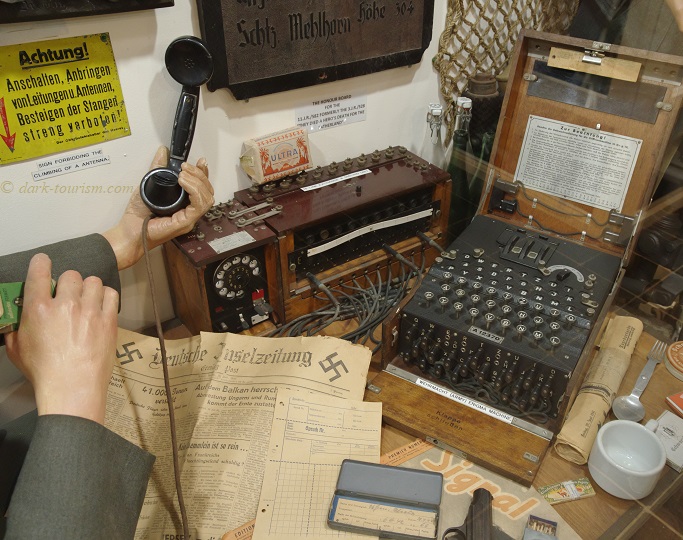
On my list of sites to see was also St Catherine’s Bunker – one of the newest dark attractions on Jersey. But for time constraints, the fact that it is located on the other, eastern side of Jersey and also because I couldn’t face another militaria collection, I decided to give it a miss. Instead I headed south to Noirmont Point, where there is a cluster of open-air sites with various installations from the Nazi occupation era.
One is Battery Lothringen, a coastal gun emplacement complex, one of whose 15cm guns has been faithfully restored:
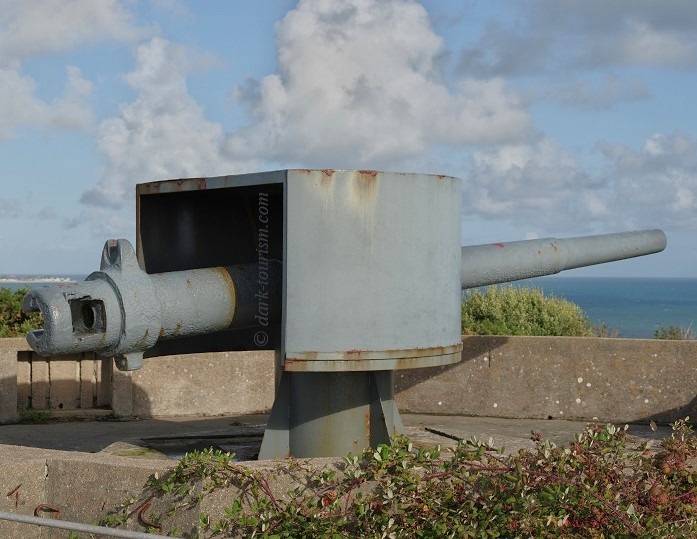
Part of the complex is also yet another one of those unique observation towers called “Marine Peilstände” (see above); this is one is Jersey’s MP 1:
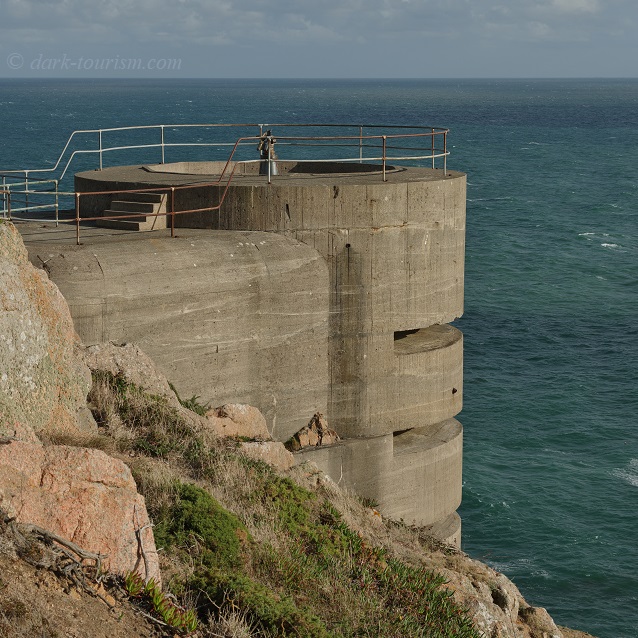
Theoretically you can visit the interior of this one – but only on very few days a year (six days in total in 2025 to be precise), and obviously I was not lucky enough for my visit to coincide with one of those.
The tower is complemented by a set of two steel-armoured cupolas housing observation periscopes (originals – the only ones to survive in the Channel Islands) plus a restored huge rangefinder, all overlooking the coast, with an early 18th century Martello Tower that now serves as a lighthouse at the bottom of the cliff:
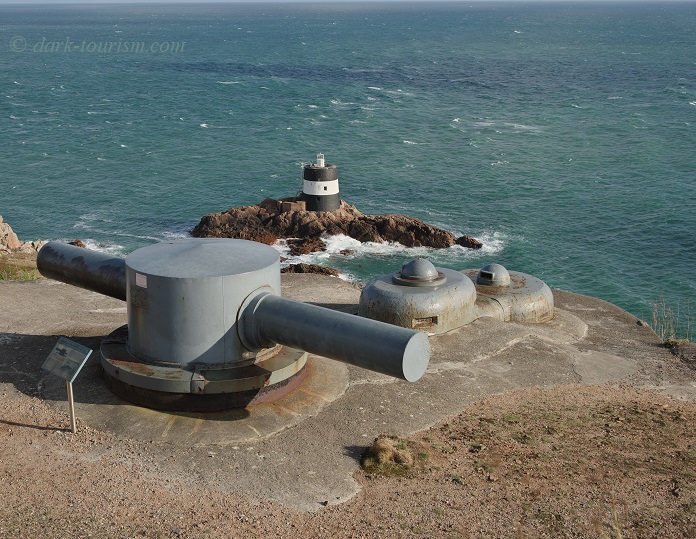
After exploring this complex, which must rank as one of the most significant open-air DT attractions on the Channel Islands, I decided it was time to call it a day and drove back to the airport to drop off the hire car, and then get the bus back to St Helier, as evening was approaching.
Back in St Helier we had a bit of a wander around the centre of town; and on Liberation Square next to Liberty Wharf Shopping Centre we came across this Liberation Monument:
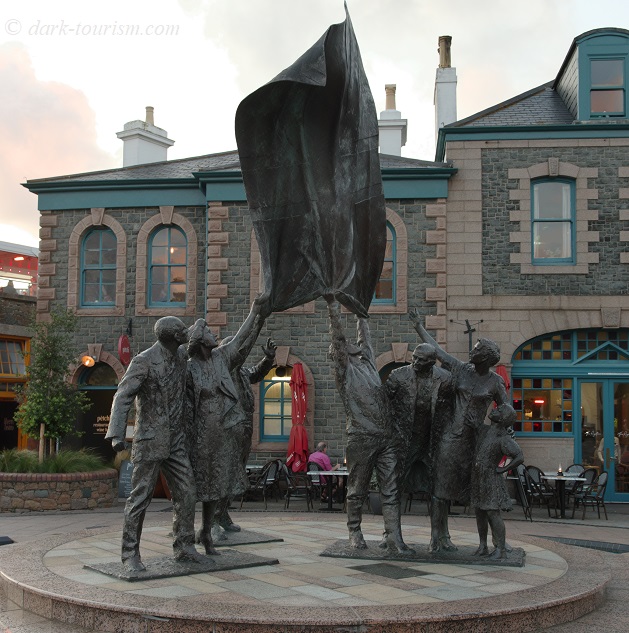
Overall, though, I found St Helier far less attractive than Guernsey’s St Peter Port. There are some fairly pleasant streets and squares and a pretty central market hall, but I thought it lacked a bit in atmosphere in comparison. It also makes so much less of its harbour front than St Peter Port. But in practical terms it does of course make a good base for tourism, whether of the dark sort or the more mainstream kind …
And with this I shall bring this rather long Blog post to a close.
.
.

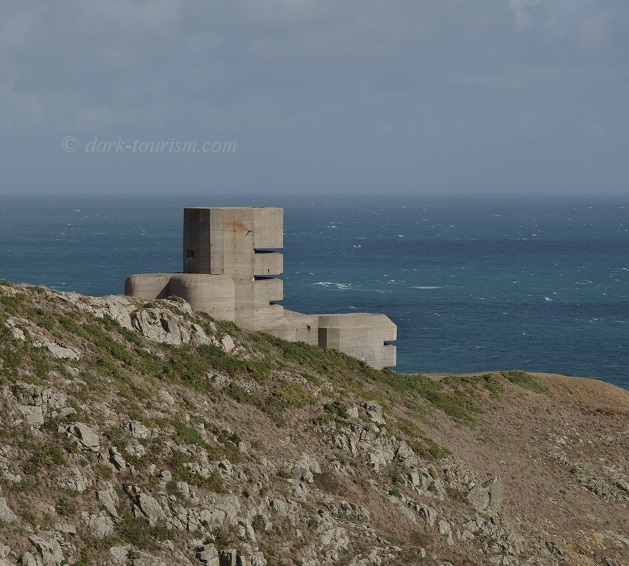
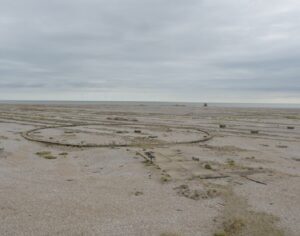
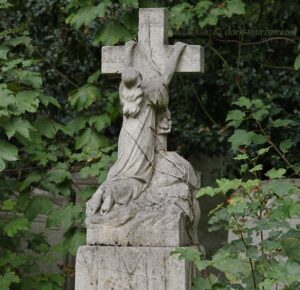
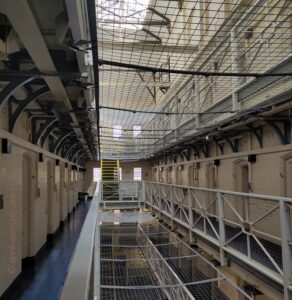
4 responses
Very interesting. I had no idea. I`ll make sure to make it there one day!
yes I can recommend it!
Nothing useful to say, but always an enjoyable read…far more than other travel blogs!
thanks a lot, much appreciated!